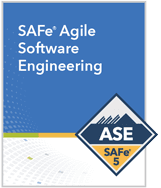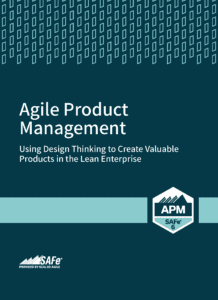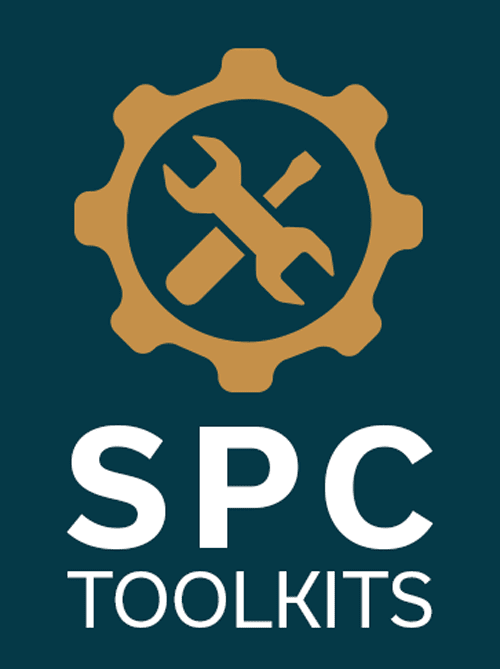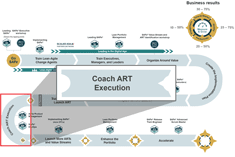
Whenever you let up before the job is done, critical momentum can be lost and regression may follow.
—John Kotter, Leading Change
Coach ART Execution
This is article ten in the SAFe® Implementation Roadmap series. Click here to view the entire roadmap.
The previous articles in the SAFe Implementation Roadmap series described the first nine steps:
- Reaching the Tipping Point
- Train Lean-Agile Change Agents
- Create a Lean-Agile Center of Excellence (LACE)
- Train Executives, Managers, and Leaders
- Lead in the Digital Age
- Organize Around Value
- Create the Implementation Plan
- Prepare for ART Launch
- Train Teams and Launch the ART
The first big events are now in the rearview mirror at this implementation stage. Teams have been trained, the first ART has been launched, and the first PI Planning event has been held. The result of all this effort is an empowered, engaged, and aligned team of Agile teams ready to build solutions that deliver value.
Before moving on to the critical work of coaching the Agile Release Train, it’s essential to understand that training and planning alone do not make the newly formed teams and ARTs Agile. They provide the opportunity to begin the journey of becoming Agile. To support this journey, leadership—and SAFe Practice Consultants (SPCs) in particular—must be mindful that knowledge does not equal understanding. It takes time to achieve effective team-level Agile practices and behaviors (typically several PIs), which is why SPCs must invest time in coaching ART execution.
Details
To reach this point, the enterprise has invested significantly in developing SPC change agents and training stakeholders in the new way of working. Now is the time for that investment to pay off, as SPCs and Lean-Agile Leaders focus on what matters: helping to assure the delivery of value in the shortest sustainable time while producing the highest quality. This typically requires significant team and ART-level coaching.
Team Coaching
While new SPCs often focus on enabling the ART level roles and events (see ART Coaching below), the foundation of ART execution is Team and Technical Agility. SPCs can provide Agile Teams with coaching in the practices of this competency.
Initially, team coaching will likely focus on mastering the team-level SAFe roles and events, tailored to align with the team method selected (SAFe Scrum or SAFe Team Kanban), including:
- Iteration planning – refine and adjust initial iteration plans developed during PI Planning
- Backlog refinement – refine and adjust the scope and definition of user stories defined during PI Planning
- Team Sync – to help the team stay aligned on progress toward iteration goals, raise impediments, and get help
- Iteration Reviews and System demos – to get feedback from stakeholders and assess progress toward PI Objectives
- Iteration Retrospectives – to review team practices and identify ways to improve
- Coach Sync, PO Sync, and ART Sync – to maintain alignment and resolve issues with other teams on the ART
- Team Assessments – facilitate the Team and Technical Agility assessment and help the team add improvement work into the team backlog based on the results.
In addition to these roles and events, SPCs help teams build their Kanban boards and processes to support tracking the flow of stories and supporting team flow metrics.
But this is only the beginning. As teams gain confidence in their roles and events, and because of the transparency they create, technical proficiency and best practice will become the next opportunity for relentless improvement. To establish a smooth and consistent flow of value, Agile Teams working on software solutions must become proficient in modern software engineering techniques and disciplines. Examples of these practices include Test Driven and Behavior Driven Development, Continuous Integration/Deploy, Test Automation, and Pair Programming (all pioneered by the Extreme Programming (XP) movement). For a summary of these practices, see the article on Built-in Quality and the Team and Technical Agility competency article.
The Agile Software Engineering course can be used as a continuing education offering during the first Innovation & Planning iteration or during a subsequent PI as need and opportunity dictate to accelerate the development of these critical software engineering disciplines.
Software engineering disciplines have evolved over the past decade with the introduction of Lean-Agile and DevOps principles and practices. New skills and approaches to software engineering help organizations deliver software-centric solutions faster, more predictably, and with higher quality.
During this three-day, workshop-oriented course, attendees will learn how Lean-Agile principles drive these changes. They will connect these principles to modern developing practices, including practices such as Behavioral-Driven Development (BDD), Test-Driven Development (TDD), and applying the Agile Testing Quadrant. Attendees will learn the best techniques to model, design, implement, verify, validate, deploy, and release stories in a SAFe Continuous Delivery Pipeline.
ART Coaching
While Team and Technical Agility form the foundation of ART execution, the Agile Product Delivery competency enables the shortest sustainable lead time to value. SPCs engage with Scrum Masters/Team Coaches across the ART to help accelerate the adoption and mastery of this competency.
As with Agile Teams, coaching the ART typically starts with the essential SAFe roles and events, including:
- PI Planning – create alignment and shared commitment to a common set of objectives
- System Demos – close the rapid feedback loop through integration and validation of working systems
- Inspect & Adapt Workshops – enable relentless improvement and systems thinking
- Coach Sync, PO Sync, and ART Sync – maintain alignment, resolve issues, and facilitate the attainment of PI Objectives
- ART Assessments – facilitate the Agile Product Delivery assessment and guide the addition of improvement work into the ART backlog based on the results.
In addition to these events, SPCs help ARTs build their Kanban boards and processes to support tracking the flow of features and supporting ART flow metrics.
But these just scratch the surface of the ART’s purpose and potential. To help ARTs optimize the flow of value, SPCs must coach ART leaders to look beyond the current PI and current capabilities. As roles and events are mastered, the focus must shift to the Continuous Delivery Pipeline and the enterprise competency of Agile Product Delivery. These competencies involve both managing and continuously improving the speed and quality of the ART’s capability to:
- Continuously Explore – Sense and respond to market/business needs to build and maintain the Solution Vision, Roadmap, Backlog, and Architectural Runway.
- Continuously Integrate – Build, validate, and learn from working system increments.
- Continuously Deploy – Deliver validated features into production, where they are ready for release.
DevOps, Value Stream Mapping, and the Problem Solving Workshop are the coach’s primary tools for enhancing these capabilities.
The SAFe DevOps course can be used as a foundation for these practices during the first Innovation & Planning iteration or for continuing education during subsequent PIs as the need and opportunity dictate to accelerate the development of this competency.
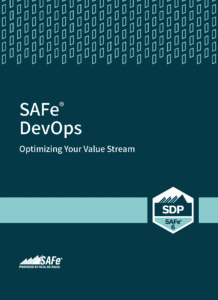
This two-day course provides a comprehensive overview for understanding the DevOps competencies needed to accelerate time-to-market by improving the flow of value through the Continuous Delivery Pipeline. Attendees will map the current value stream through their delivery pipeline from idea to cash and identify practices that will eliminate bottlenecks to flow.
The course will build an understanding of the complete flow of value from Continuous Exploration to Continuous Integration, Continuous Deployment, and Release on Demand.
Attendees will leave with the tools they need to execute an implementation plan for improving their delivery pipeline and the knowledge they need to support the plan. The course prepares learners for the optional SAFe® DevOps Practitioner (SDP) certification exam.
With SAFe DevOps, the ART is learning to build, manage, and improve its value stream output and efficiency. Helping key roles move from a project to a solution-based mindset is also key. This ensures the right value is moving through the system more effectively.
Historically, many in the development organization have been tasked with ‘projects ‘to complete, while the capacity and acumen for designing a market strategy, penetrating new markets, designing persona-based solutions, and design thinking sit either outside of the solution development or is non-existent. In SAFe, these skills are critical to forming ‘whole product thinking’ teams and ARTs who can design, build, deploy, and release customer-centric solutions. SAFe’s Agile Product Management course creates a foundation for these skills and results in concrete actions Product Managers, strategists, Business Owners, UX designers, and Solution Architects can start utilizing immediately. Course attendees will explore defining a vision, strategy, and roadmap for existing and future customers, thereby providing the teams the clarity they need to build solutions that delight their customers.
SPCs and Agile coaches will be critical in ensuring these practices and learnings become common usage, unblocking time for more strategic thinking. Indeed, there’s no shortage of opportunities for SPCs and Lean-Agile Leaders to practice and demonstrate their new skills and mindset.
Inspect and Adapt
No coaching opportunity is more critical than the first Inspect and Adapt workshop. That’s where everyone will learn how the PI went, how the teams performed against their PI objectives, how well the organization is adopting SAFe, and how the solution they developed really worked at that point in time. In addition, SPCs and coaches can lead the first real corrective action and problem-solving workshop.
This workshop gives teams the tools they need to improve their performance independently. It also allows them to work together with their management stakeholders to address the more significant impediments they face collaboratively.
Moving Forward
For the first ART, it’s onward in its journey of relentless improvement. But for the reader, it’s on to the following article in the Implementation Roadmap series: Launch More ARTs and Value Streams.
This article serves as a launching pad to explore these steps in detail and understand how to apply them to specific implementations.
Additional Resources
SAFe PI Planning Toolkit, SAFe PI Execution Toolkit
Last update: 13 March 2023
